#kurchatov
Text

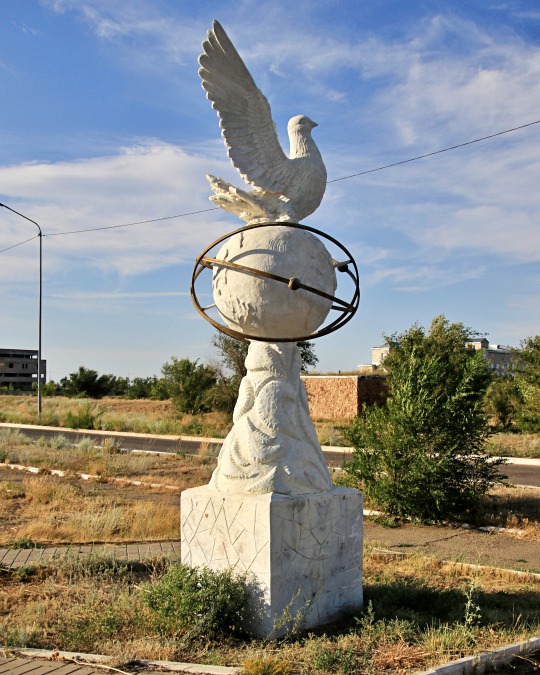
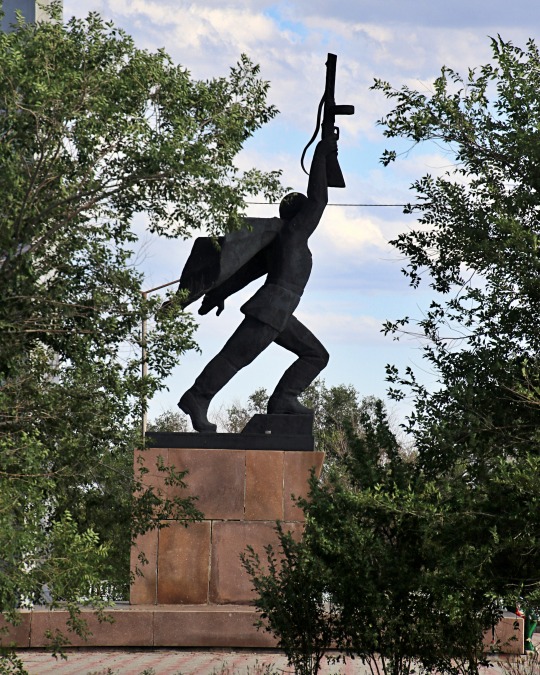


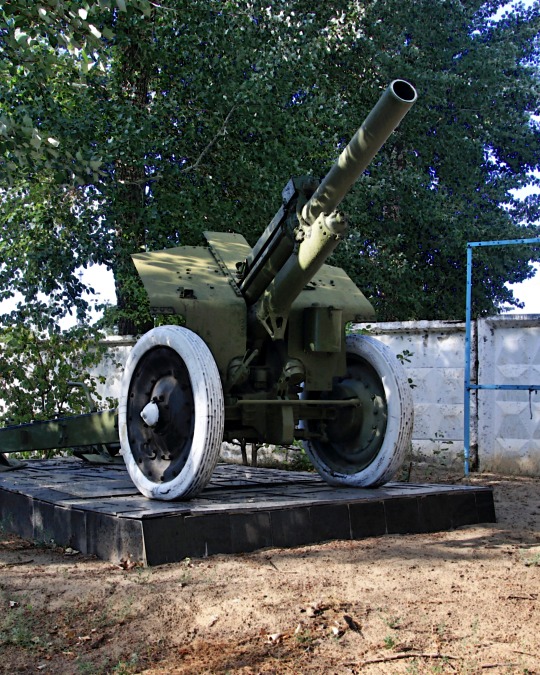
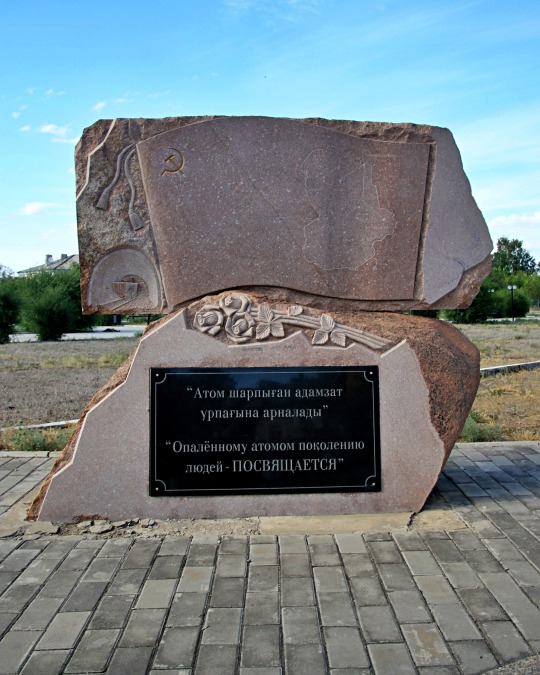
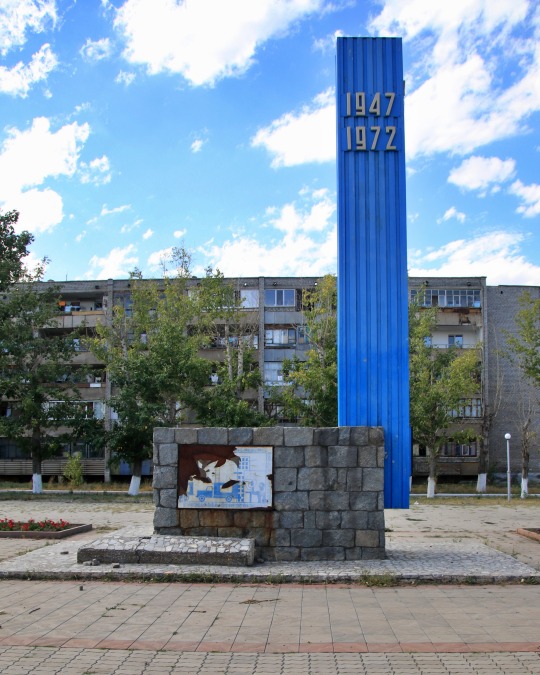


post-soviet town Kurchatov ( Kazakhstan ) - the former operations center for the adjoining Semipalatinsk Nuclear Test Site
#travelphotography#photooftheday#adventure#aroundtheworld#landscape#monuments#kazakhstan#kurchatov#soviet union#soviet art#soviet aesthetic#atom bomb#nuclear testing#ussr#explore#travel#history daily#kazakhstantravel#pickoftheday#semipalatinsktestsite#nuclear bomb#nature#cccp#atom
9 notes
·
View notes
Text
Kurchatov Institute and surroundings
29.07.2023
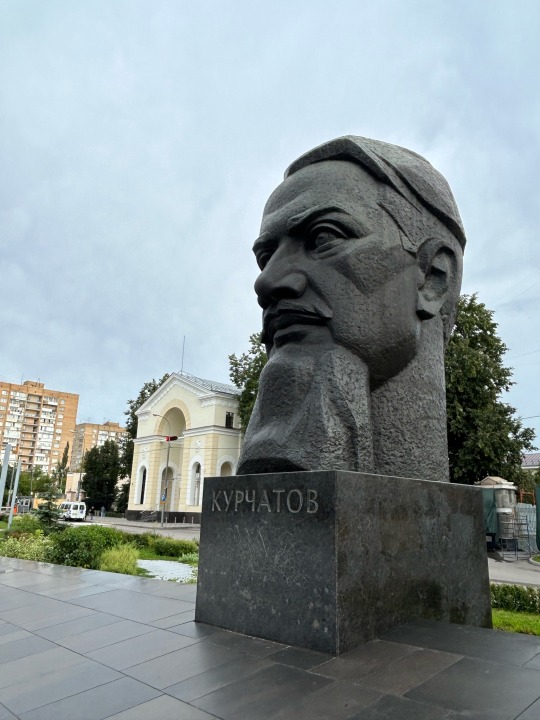


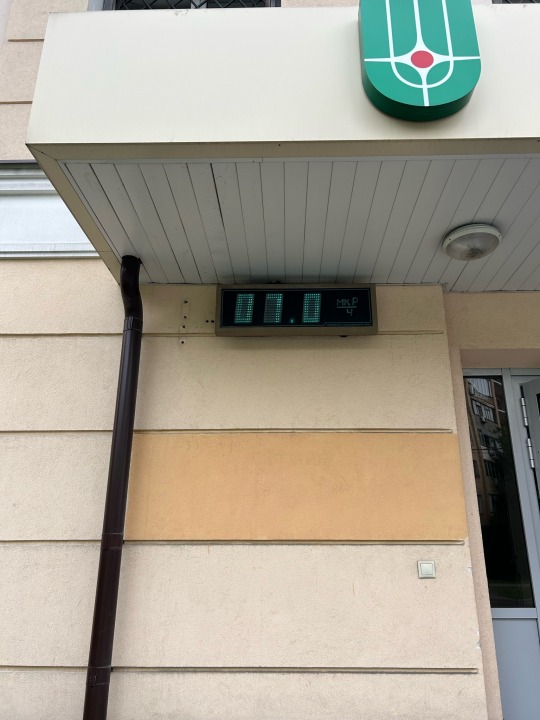


17 notes
·
View notes
Text
The Search for the Fuel: The Elephant’s Foot

From the first days of the accident, locating and monitoring the 190 tons of nuclear fuel that had been in the fourth reactor at the time of the explosion was a top priority for the commission overseeing the cleanup. They wanted to ensure that no further disasters would unfold at Chernobyl; with the Soviet Union's international prestige already significantly battered, it was critical that they felt in control of the situation once more. After the initial plume of radionuclides from the burning reactor declined significantly in the early days of May 1986, it was established by the scientists assisting the Commission that the nuclear fuel had three distinct hazards that it could present. These were a radioactive hazard, a nuclear hazard, and a thermal hazard.
Perhaps the most obvious, the radioactive hazard was that of the aforementioned radioactive cloud rising from reactor 4. Although it had decreased significantly, it was still a danger and could potentially flare up again unless measures were taken to prevent it.
The nuclear hazard was the fear of a new uncontrolled nuclear chain reaction like the one that had initially destroyed the reactor. The state of the core was unknown at this time, and scientists had to determine if any of the reactor assembly was still in place and if it or any other mass of fuel had the necessary elements to sustain another catastrophic reaction. Basically, it was a possibility that the fuel could gather in such a way that a new nuclear chain reaction would start.
Finally, the thermal hazard was that of the hot nuclear fuel melting through the concrete of the unit block and into the Earth below. This is known as the “China Syndrome” after a movie of the same name. It was also feared at the time that the fuel could melt down into the bubbler tanks below the reactor, which stored a large reservoir of cooling water, and cause a significant steam explosion. This was the main concern of the government commission and the most effort was put in place to reduce this hazard first.
Having established the potential dangers of the fuel the Commission wanted absolute assurance that the hazard was not an immediate threat to the safety of the workers at Chernobyl and the world at large.
This undertaking was assigned to the team of experts assembled by the Kurchatov Institute, a scientific institute for the study of nuclear physics. It was established early on that most fuel was somewhere within the ruins of the fourth unit, since very little was ejected by the explosion. The building itself was enormous, with winding passages known only to those who worked for years in its labyrinthine walls.
Below: A schematic diagram of the fourth unit block seen from the west. The dimensions of the building are marked in meters. Note the enormous region of rooms located below the reactor core (Closed Reactor Space on this diagram). The area at the bottom of the building with the large vertical pipes are the bubbler tanks that held emergency cooling water for the reactor. This was the area scientists feared a steam explosion if the fuel lava gained access.
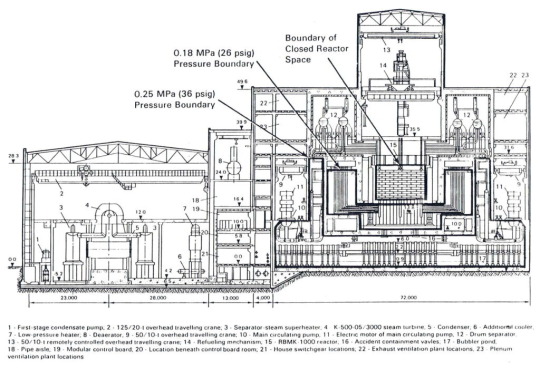
Adding to the problem of the scale of the search area was the fact that the building was potentially unstable due to the explosion of the fourth reactor. Rubble filled hallways and walls and ceilings sagged dangerously. Radiation levels fluctuated wildly within the building, with some areas almost entirely safe and others able to cause sickness and death in minutes. Even more pressing was that starting in the spring of 1986, the lower levels of the fourth unit began to slowly fill with fresh concrete. The Ministry of Medium Machine Building unit US-605, who were building the Sarcophagus to cover the radioactive remains of the unit, poured concrete into the structures of the Sarcophagus 24 hours a day. However, huge gaps and sinkholes existed in their work area, and a good portion of the concrete pumped into the Sarcophagus ended up deep in the lower levels of the block. This concrete blocked hallways, doors, and even (as they would later come to learn) covered up some of the melted fuel.
It was not until late spring of 1986 that exploration of the fourth unit block began. In June of 1986, two men were probing a steam distribution corridor in the southeast corner of the block from another corridor just below it using a powerful dosimeter which could detect radiation levels of up to 3,000 roentgens per hour. Since radiation levels in the stairway up to the corridor they were probing were already quite high (~25 roentgens per hour) they decided to send the detection head of the device up the stairs ahead of them via an assembly of metal rods. As soon as the device entered the corridor above, it went off the scale and burnt out. From this result the team was able to pinpoint a source of extreme gamma radiation.
In December of 1986, and expedition was mounted to room 217/2 to make visual contact with the suspected fuel concentration. Moving along the steam corridor this time, the team spotted a large metallic gray mass sitting neatly within the corner of the room. This formation was dubbed the "Elephant's Foot" (though some source translate it as"Elephant's Leg") due to its similarity to the leg of an elephant. The black glassy mass emitted over 8,000 roentgen an hour, deadly after just one and a half minutes (this is the maximum recorded emission, the levels would decrease significantly in the months after the disaster). For the first time, the theory of fuel lava was visually confirmed. The team branded the materiel "lava-like fuel containing masses" (LFCM).
Below: A picture of the Elephant's Foot from the direction which it was first observed. The railings just behind the main formation (Label 1) is the railing around the metal stairs from which the formation was first detected via dosimeter. Note the streaks of fuel above the formation showing where the fuel had dripped down from above. Label 4 denotes the "fresh" concrete that made its way into the building during the construction of the Sarcophagus.

Below: a view of room 217/2 from above. The red is the Elephant’s Foot, the orange is the fresh concrete, and the gray are the walls of the block. The Foot itself is the accumulation closest to the bottom left of the photograph. You can see there is more lava in an unnamed formation next to it.

After locating the fuel and taking some pictures, the team was tasked with analyzing what the lava was composed of. This may seem kind of obvious, but really it was not known what was in the LFCM. Presumably the fuel of course, but what else? It had been debated from the early days of the accident if the efforts to douse the fire and melting fuel with lead, boron, and sand had been effective (I refer here to the April 26th-May 12th aerial bombardment campaign of the reactor via helicopter- I will make a post on this effort at a later time and link it here). The contents of the fuel is an interesting topic which I will not go over more in this post. You can find more info on the quest to get a piece of the LFCM here.
After procuring a sample, one issue remained. They had found some of the fuel, but nowhere near the total amount. The grand majority of the fuel had yet to be located. By the summer of 1987 the fresh concrete that had run into the lower levels of the block began to cause real obstacles to the scientists. Many rooms suspected to contain fuel were inaccessible or could not be reached safely. A new approach was needed.
At the end of 1987 the Kurchatov team was reassigned to be part of the adventurously named Chernobyl Complex Expedition (CCE), an enormous liquidation effort that was tasked with exploring the interior of the Sarcophagus and locating the rest of the fuel in the years after the disaster. The CCE was composed to representatives from all the major Soviet scientific institutions, as well as builders and engineers. At its peak over 3,000 people worked as part of the Expedition. Through it all, the main core of this group was the scientists from the Kurchatov Institute.
Backed by resources of the entire CCE, the scientific team sought new approaches for searching for the fuel. After extensive discussion, the scientists came up with a rather ingenious solution. They would use coring drills like those used in oil drilling exploration set up in specially decontaminated rooms in the fourth unit block to drill so called ‘wells’ into inaccessible rooms. Through these they would send specially built monitoring equipment. These included thermometers, periscopes, and radiation sensors. Not only could they monitor the LFCM with this equipment, they could also obtain information about the building and the LFCM via analysis of the cores made by the drill. This allowed them to remotely locate, monitor, and sample the LFCM with minimal risk to personnel.
Below: A schematic of the wells drilled at the 9 meter mark below the reactor containment vessel. The purple lines are the wells themselves, with the gray being the concrete walls of the block. The large blue cross is the metal support Scheme S. I provided this as an example of how the wells were drilled and laid out. For more info, feel free to contact me.

Below: a member of the CCE operates a drill in the bowels of the fourth unit block. Note the protective clothing he is wearing to prevent the spread of airborne radiological contamination.

Between 1988 and 1992 a total of 134 wells were drilled between the 9 and 16 meter marks (the method by which levels of the plant are identified) and at the 20, 21, and 25 meter marks. It was eventually determined that over 180 of the 190 tons of fuel remained in the reactor block. The missing ten tons had either been blown out of the active zone and into the area around the reactor by the explosion, or had vaporized into the radioactive column that had emerged from the reactor in 1986. The remaining fuel within the block took the form of the LFCM, as well as dust. The dust created by the fuel is the main radiological enemy post 1986 and continues to be an issue to this day. Primarily composed of plutonium, the dust has thankfully remains mostly within the Sarcophagus. The LFCM, initially almost indestructible, has started to crumble and decay. As time goes on this creates even more dust, and the formations slowly erode away. This has contributed to a significant drop in gamma radiation emissions from the fuel masses and allowed for further study of the premises of the fourth unit block.
In 1994, the Complex Expedition used data collected from these wells to compile an official report on the status of the fourth unit block. With their findings published (and the Soviet Union dissolved) the CCE disbanded. Many of the scientists who worked on the expedition (and even some who were on the original Kurchatov Institute team) continued to work at Chernobyl for years. Expeditions are still sometimes mounted into the Sarcophagus, but they have not been carried out with any regularity since the early 2000s. However, visual inspection remains the only way to accurately monitor the condition of the LFCM.
You may be left wondering: how exactly did these men navigate such a radioactive environment without adverse effects? Once again I shall make a post on this in the future, but the main answer is: speed! Defense against radiation (with some exceptions) is as simple as not lingering in high radiation areas. To facilitate safe movement through the block, the scientists located and marked safe areas of reduced radiation levels (such as the room in this post) as well as dangerous areas to avoid. In the end, only a select few “Stalkers” actually set foot within the ruins of Reactor 4.
This post serves as the (admittedly lose) historical context for the exploration of the fourth unit block and the location of the LFCM. I will be making another post about the fuel rest of the fuel soon. I always feel bad for the other fuel formations because the Elephants Foot gets all of the attention. This will be a lot more technical, with locations and diagrams (joy of joys!) of the fuel as well as more context to its identification.
#chernobyl#elephants foot#radiation#history#autism#nuclear#nuclear power#reactor#china syndrome#chernobyl complex expedition#accidents and disasters#kurchatov institute#LFCM#chnpp#soviet union
92 notes
·
View notes
Text
#Niels Bohr#Stephen Hawking#Robert Oppenheimer#Wolfgang Pauli#Werner Heisenberg#Richard Fineman#Isaac Newton#Ernest Rutherford#Igor Kurchatov#Paul Dirac#my dead physicist boyfriends
68 notes
·
View notes
Text
Round 1.2: Oganesson (118) vs. Rutherfordium (104)

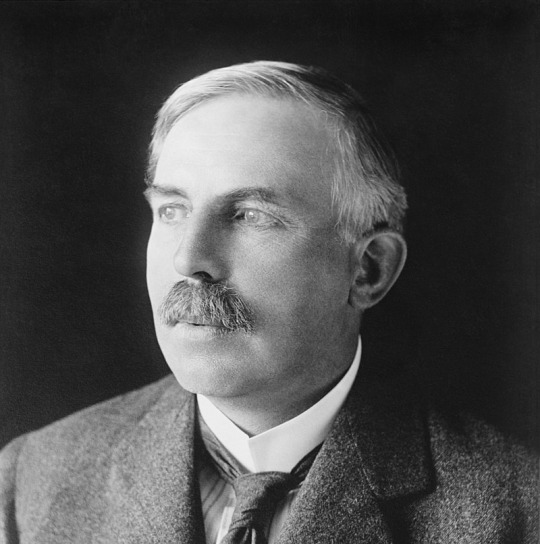
Oganesson (118)
Oganesson is an extremely radioactive, short-lived, superheavy element named for the still living nuclear physicist, Yuri Oganessian. A synthetic element, it has the highest atomic number of any discovered element and is technically a noble gas. With no research done on actual samples due to difficulty of production (only 6 or 7 atoms total ever), researchers still dispute whether it would be a solid or a gas in standard conditions, although solid appears to be the current consensus.
Rutherfordium (104)
Rutherfordium is a radioactive, short-lived, superheavy element named for the so-called father of nuclear physics, Ernest Rutherford. Most likely acting as a heavier homolog to Hafnium, Rutherfordium has had little research done on it.
pick an old man to fuck
#fuckable elements poll#oganesson#rutherfordium#ernest rutherford#yuri oganessian#which old man do YOU want to fuck?#I love reading about the naming controversies related to the superheavy elements#We could have had Kurchatovium#and Igor Kurchatov is something to look at
5 notes
·
View notes
Note
Actually why did my country make a “Fuck you with the wraith of a thousands suns!” weapon in the first place? Thought many would think we were playing god too much.
Because Nuclear fission was discovered accidentally in Nazi Germany on December 21st, 1938, nine months before the beginning of the Second World War.
The German radiochemists Otto Hahn and Fritz Strassmann, working at the Kaiser Wilhelm Institute for Physical Chemistry in Dahlem, a suburb of Berlin, were bombarding a solution of uranium nitrate with lukewarm neutrons, transmuting microscopic quantities of the uranium into a brew of substances of differing characteristic radioactivities which the two chemists believed might include new manmade elements heavier than uranium as well as familiar elements like radium, one of uranium’s natural “daughters.”
Instead of radium, however, Hahn and Strassmann found barium in their irradiated solutions, an element only about half as heavy as uranium that they had not expected to find there and that had not been there before.
When they had consulted with their Jewish physicist colleague Lisa Meitner, who had escaped Nazi Germany to exile in Sweden, and when Meitner had consulted with her physicist nephew Otto Frisch, who came over from Denmark to visit her, it became clear that the unexpected barium was a marker for a new form of nuclear reaction.
Tthat in fact Hahn and Strassmann’s neutrons had split uranium nuclei into two nearly equal pieces, one of barium, and one of krypton.
The new reaction, converting a small amount of matter into energy, was fiercely exothermic, ten million times as much energy coming out as the neutrons carried in.
Physicists had known for forty years, ever since the discovery of radioactivity, that enormous energy was locked up in the atom.
Here at last was a way to release it.
Otto Hahn, a veteran of the First World War, said later that he brooded on the probable military applications of his discovery and seriously considered suicide.
Word spread quickly across the world community of physicists.
Bohr carried the news to America early in 1939 in the course of attending a physics conference in Washington.
Soviet physicists working in Leningrad under Igor Kurchatov, British physicists, German physicists, the French team at the Radium Institute in Paris, American experimenters from coast to coast rushed to demonstrate nuclear fission in their laboratories with off-the-shelf equipment.
A Japanese Army lieutenant general who was an electrical engineer, reading the report in Nature, assigned a member of his staff to track it.
If America was not the one to do it, other nations would have done so, and we would have lived in a vastly different world.
45 notes
·
View notes
Text
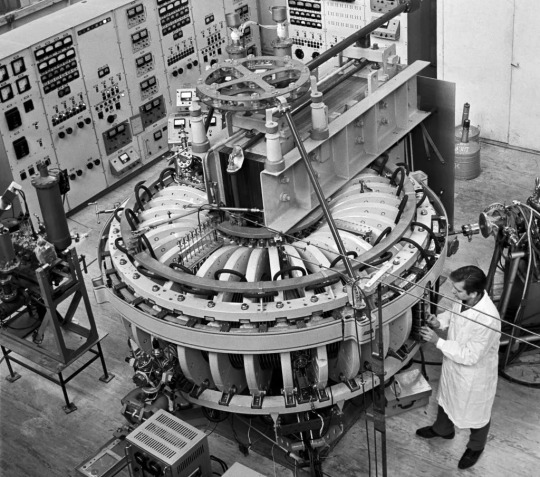
The 'Tokamak-6' Installation in the Plasma Studies Department
The I. Kurchatov Institute of Nuclear Physics, Moscow, 1970
image credit: Oleg Kuzmin/TASS from SOVFOTO
36 notes
·
View notes
Text
I swear I was only looking for Valoris reference pics...
I was doing a google image search for a better quality version of a Valery pic, and not only did I find it in high res, I found a BUNCH of pics I had never seen before. *___*
There's one more publicity shot from their first Kremlin scene but I've never seen this one before. Look at Boris' deadly glare, tilting his head to the side as if he's about to chew off Valery's face. And those massive fingers. <3
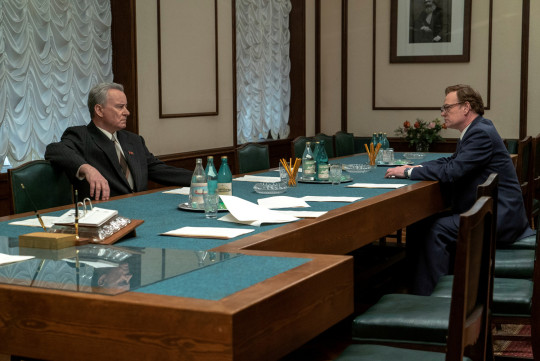
Boris Shcherbina towering over incompetent fools.
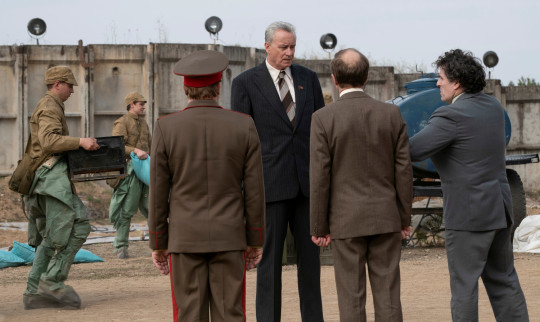
Is Valery tied up? Or maybe Boris sees him that way...

First night together. 💗 As Pikalov put it, "There's a hotel... 😉".
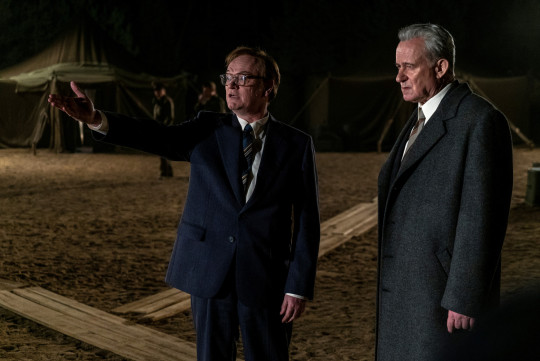

That Boris profile. ❤💗
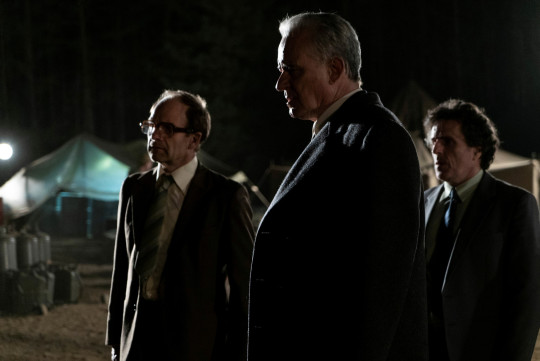
Seeing them from the back during the rooftop scene.
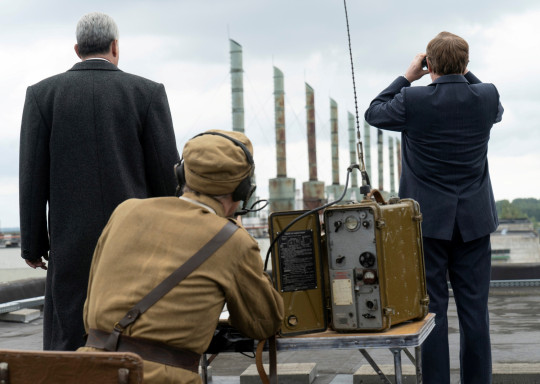
Suspenders porn. Is Valery sneaking glances at Boris while revealing just a few tantalizing inches of his suspender? "I swear it was completely by chance."

...And that explains what Boris' massive hands are doing there. 👇

Boris has no choice but to spring to his feet and get a closer look at those naughty suspenders.

Sad Boris is sad. TT__TT

...but at least now he has someone to look up to.

Look at Boris' compassionate look as he gazes at his Valery who is burdened with a horrible dilemma. 😭

A clearer, more detailed photo than the other Valery/Ulana publicity shot we have and guess what, the deputy director of the Kurchatov institute loves him some Шекспир. 😁 Makes me wonder which play of The Bard is his favourite one.

The day of reckoning...

But before their world falls apart, before they lose each other forever, they have one last moment, they have The Bench.
They will always have The Bench.
💔

Btw why is that guard smiling wtf. Does he ship them too??
P.S.: It does make you wonder though just how MANY other Chernobyl publicity shots are out there and we haven't found them yet.
And I mean it's been years.
#chernobyl#craig mazin#valery legasov#jared harris#boris shcherbina#stellan skarsgard#publicity shots#rare stills#ulana#emily watson#con o'neill#adrian rawlins#fomin#bryukhanov#valoris#have those been posted on tumblr before?#I have seen some of them just not all of them#I mean wow
91 notes
·
View notes
Text
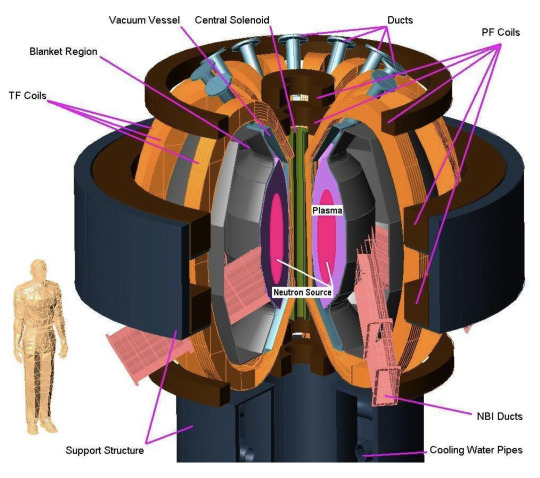
FNS-ST: basic parameters and cut-view, Development Status of the Russian DEMO Project, Russian Federation DEMO program, Boris Kuteev, IAEA DEMO-6, Rosatom Tech, Moscow, RF, October 1-4, 2019, National Research Center Kurchatov Institute (source)
8 notes
·
View notes
Text
The Heavens declared the glory of the Bomb, and the firmament showeth His handiwork.

He descendeth from the outermost part of Heaven and there is nothing hid from the heat thereof. There is neither speech, nor language, yet His voice is heard among them.

Glory be to the Bomb, and to the Holy Fallout. As it was in the beginning, is now, and ever shall be. World without end. Amen.
“The head of the Russian Orthodox Church, Patriarch Kirill, has said that his country's nuclear weapons saved the nation.
Kirill, who has justified Russian President Vladimir Putin's decision to invade Ukraine in February 2022 on spiritual and ideological grounds, made the remarks on October 18 as he presented a Church honor to physicist Radiy Ilkaev, an honorary scientific director of Russia's Federal Nuclear Center in the town of Sarov.
(…)
Russia's nuclear weapons were created under "ineffable divine providence," Kirill said.
"Were it not for the work of [Soviet atomic bomb creator Igor] Kurchatov and his colleagues, it is difficult to say if our country would still exist," he said.
Soviet scientists "created weapons under the protection of St. Seraphim of Sarov because, by the ineffable providence of God, these weapons were created in the monastery of St. Seraphim," Kirill said. "Thanks to this power, Russia has remained independent and free, and, of course, we must all cherish this remarkable feat of our scientists, who practically saved the country, in our hearts and memories."
(…)
Kirill has justified Putin's decision to invade Ukraine by saying Russia is a "peace-loving power" that does not engage in "military adventures."
In June 2022, he said that Russia was being attacked all over the world because of feelings of jealousy, envy and indignation, adding that he believed this was happening because Russia is "different."” - Putin's Top Priest Says Nuclear Weapons Are 'Divine Providence'
#russia#russian orthodox#kirill#patriarch#nuclear weapons#atomic bomb#soviet#planet of the apes#beneath the planet of the apes#alpha omega#wwiii#world war 3#ukraine#russia ukraine war#vladimir putin#putin
6 notes
·
View notes
Text






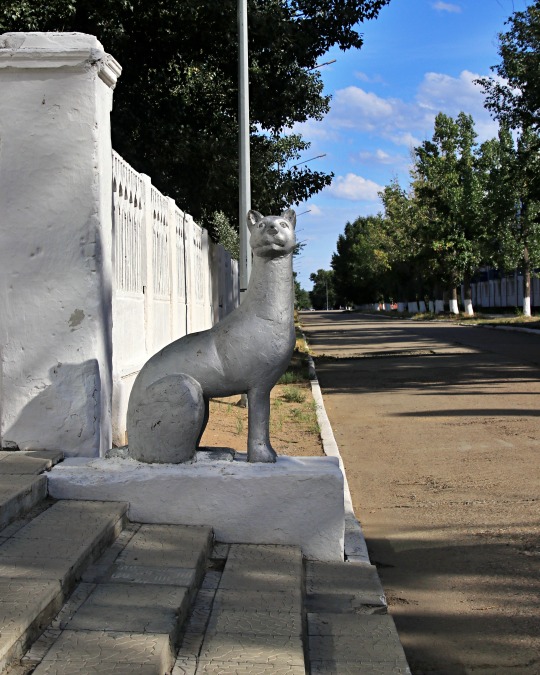
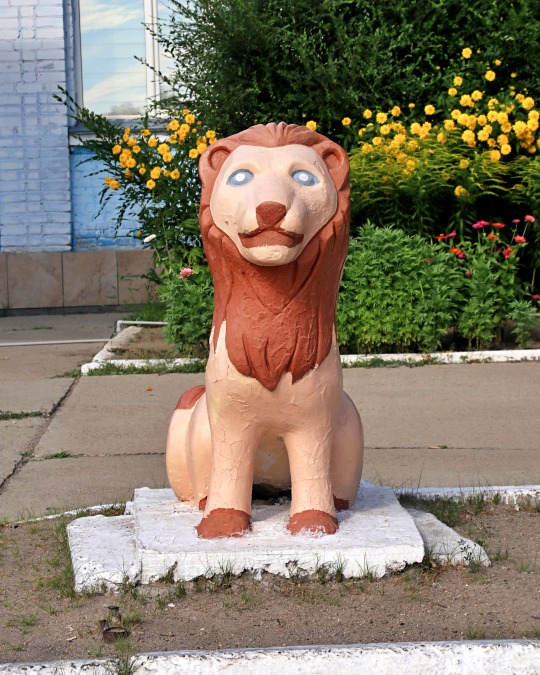
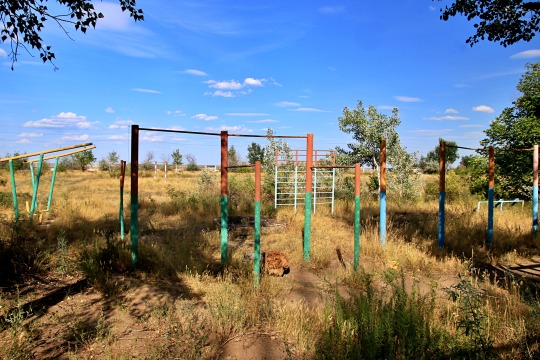

post-soviet town Kurchatov ( Kazakhstan ) - the former operations center for the adjoining Semipalatinsk Nuclear Test Site
#travelphotography#photooftheday#adventure#aroundtheworld#atom bomb#nuclearpolygon#semipalatynsktestsite#kurchatov#travel#pickoftheday#explore#kazakhstantravel#nuclear test#nucleartestsite#nature#central asia#landscape#kazakhstan#trip#soviet architecture#ussr#cccp#soviet union#soviet
5 notes
·
View notes
Text
Something that will make your evening really good :)



youtube
#valery legasov#chernobyl#valerylegasov#валерий легасов#chernobyl disaster#чернобыль#Soviet video#kurchatov institute#курчатовский институт#Александров#Легасов#Youtube
27 notes
·
View notes
Text
The Only Successful Chernobyl Robot: The Toy Tank

Chernobyl is a notable example of the use of robots to clean up and scout out areas hazardous to human workers. The robots of Chernobyl are infamous amongst the Liquidators who worked with them for their unreliability and expense. Because of their cost and the way Soviet procurement worked, any robot that failed while being used had to be retrieved by the Liquidators. Since most of the robots died in high radiation areas, many men were 'burned' (met their radiation quotas) just to get them into relative safety where they could be repaired or scrapped. There is, however, one notable exception to this trend; the Toy Tank (seen in the photo above).
Purchased by a liquidator in Kiev for 12 rubles (~$5) in 1986 after the Chernobyl disaster, this plastic tank had a short cord attaching it to its remote controller. It could move forwards and backwards, turn, and rattle to imitate firing its gun. After being brought to the Chernobyl Zone, it was quickly retrofitted for use at the CHNPP. The controller wire was extended to ten meters, and the tank was retrofitted with a flashlight, thermometer, and dosimeter. Using these tools, the tank could be sent ahead of exploration teams in the warren of rooms and hallways of Unit 4 as a 'hunting dog' to do primitive dosimetric and temperature exploration. This allowed the Liquidators to move with far more safety and caution into the depths of Unit 4.
The tank was procured and used by the Chernobyl Sarcophagus Exploration Team, a group of scientists from the Kurchatov Institute tasked with locating and monitoring the uranium fuel of Reactor 4 within the Unit Block. Nuclear fuel gives off radiation and heat, and so the tank was used to keep the team out of any unexplored rooms that may have contained these hazards. The tank was by all accounts extremely effective, and as an added bonus was far easier to decontaminate than the complex robots provided by various science ministries.
The performed its task deftly and with great success until the spring of 1987, when it became impossible to decontaminate any further. It was entombed in the Sarcophagus which it so dutifully explored.
This may seem like an urban legend or a wacky story made up by a tour guide, but it is in fact corroborated by countless memoirs and interviews with Liquidators. Also, no discredit to the other robots that served admirably at Chernobyl. There were probably other, equally as effective robots used in the zone, but this is the one most people who worked at the CHNPP itself speak of with any form of reverence.
Borovoi, A. A. (2017). Chapter 5: Robots. In My Chernobyl: The human story of a scientist and the Nuclear Power Plant Catastrophe (pp. 68–69). essay, Piscataqua Press.
BONUS STORY!
The Toy Tank does have a big brother, three (some sources say four) ISU-152 self propelled gun that were used to demolish large buildings in the Chernobyl Zone.
Below: One of the ISU-152 'Demolition Tanks' used in the Chernobyl Zone. The New Safe Confinement covering Unit 4 can be seen in the background.
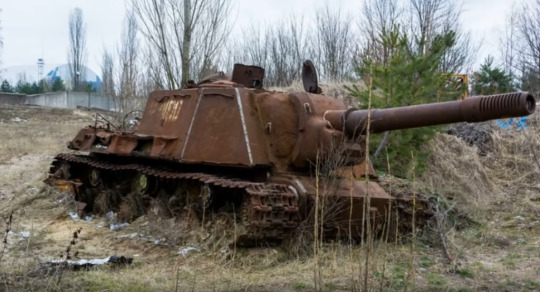
Click here for more info on the ISU-152s
#chernobyl#tank destroyer#radiation#history#toy tank#armored vehicle#accidents and disasters#russian armor#disasters#chnpp#sarcophagus exploration team#chernobyl hbo#autism#disaster#nuclear#kurchatov institute#alexander borovoi
58 notes
·
View notes
Text

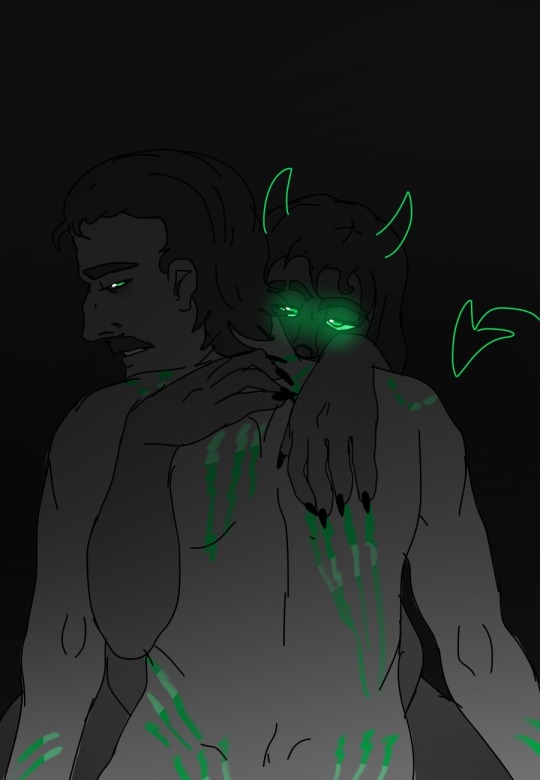
“Never seen another girl this perfect..” - Ecstasy, SUICIDAL-IDOL
(These are my Chernobyl ocs Yakiv Pavelkovich and Roksana Kurchatov)
2 notes
·
View notes
Text
Let me be late for a ride in Ukraine, but I managed to see Kazakhstan. Over the past month, I have visited almost all major cities of Kazakhstan. Hitchhiking and trains traveled along the route Samara - Orenburg - Orsk - Rudny - Kustanai - Kokchetav - Astana - Ekibastuz - Solnechny - Pavlodar - Kurchatov (with a trip to the landfill) - Semipalatinsk - Ust-Kamenogorsk - Shuak - Karaganda - Temirtau - Alma-Ata - Zhezkazgan - Satpayev - Baikonur - Aktobe - Samara.
And now the impending deterioration of relations with Kazakhstan does not bother me at all.
I have just returned to my homeland, crossed the border, and it is already winter here, the snow is lying...

16 notes
·
View notes
